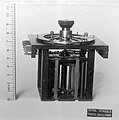English: This image shows a Royal Navy Signals Establishment's S 25 model radiogoniometer's internal workings. The key element, the "sense coil", is roughly centred in the image, with a small set screw in the middle of its mounting. The knob on top rotates the sense coil around the vertical axis, which the screw is set into.
Radiogoniometers generally have two sets of coils of wire set at right angles, either spread out over a frame, or as in this case, bunched together into two sets. Two sets of these coils are clearly visible face-on to the camera, while the second set can only be seen running left-right across the top of the internal frame(of the other set of coils). The vertical sections of the second pair is hidden behind the vertical supports.
Radiogoniometers operate by re-broadcasting a radio signal received in two antennas in the coils seen in this image. The internal sense coil is then spun using the knob on top in order to look for the point where the signal disappears, or alternately, reaches a maximum. This point is indicated by the pointer just below the knob, pointing to the lower right. The S 25 model also includes two additional pointers, one pointing to the right and the other with the small knob on top pointed to the lower left. As the signal very rarely reaches a perfect maximum or "null", the operator would point these to the extremes of the reception pattern, an a simple mechanism would move the center pointer to the average of the two angles.
On the left are a series electrical contacts used to connect the mechanism to the receiver unit. This mechanism was dropped into the larger assembly and held in place by screws in the holes seen in this image.



